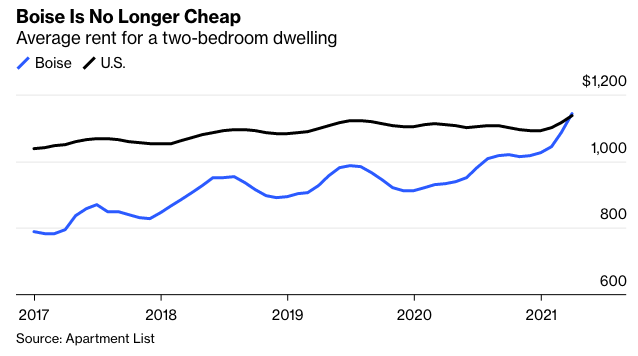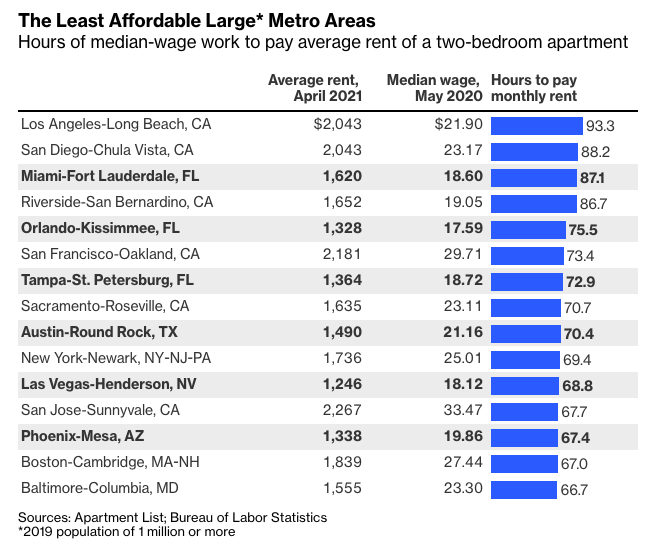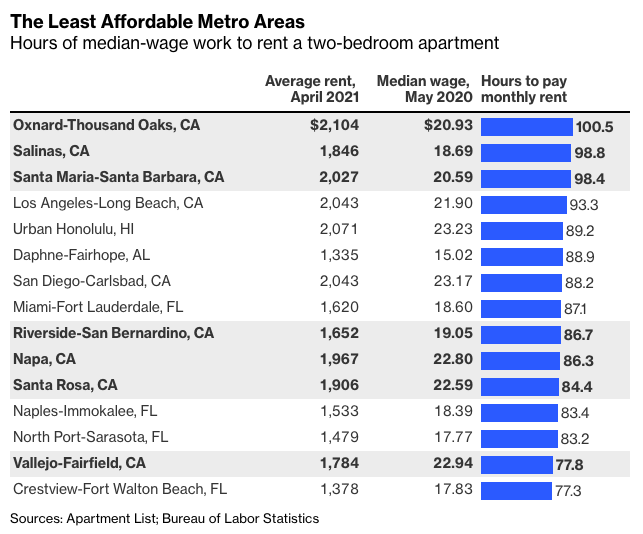Since the beginning of the pandemic, the price of housing has risen in some relatively cheap places in the U.S. and fallen in some expensive ones. These dynamics were already apparent before Covid-19, as superstar cities in the U.S. and abroad began to price themselves out of reach for many of the workers who kept them going. Then came a contagious disease that (1) temporarily shut down most of the things that make superstar cities attractive and (2) led employers to experiment with remote work on an unprecedented scale, making it easier to disconnect superstar-city jobs from superstar-city real estate prices.
Still, there’s this pesky thing that happens when the price of housing rises a lot in a place where it used to be cheap: The place stops being cheap. Consider Boise, Idaho, which saw the sharpest rent increases over the past year of the 519 U.S. cities for which the economists at Apartment List make monthly rent estimates. Four years ago, renting a two-bedroom apartment or house in Boise cost 25% less than the national average, and even early last year it cost 17% less. As of April, it cost 1% more.

No, 1% isn’t a lot more, and Boise remains a bargain compared with many of the places people are arriving from. There are 30 California cities in Apartment List’s database with average April two-bedroom rents more than twice Boise’s $1,144. But for those who aren’t earning big-city wages and don’t have bank accounts padded by big-city real estate gains, Boise is getting to be somewhat expensive. For those hoping to buy rather than rent, it has been for a while: According to Zillow’s home value index, the price of the “typical” mid-range house in the Boise metropolitan area passed that of the typical house nationally in 2013, and as of March it cost 53% more.
To get a better sense of the strains that the great pandemic migration may be putting on typical workers’ housing budgets in some of the places where people have been moving, I compared the Bureau of Labor Statistics’ most recent estimates of median wages by metropolitan area (from May 2020) to Apartment List’s April 2021 metro-area rent estimates, which combine findings from the Census Bureau’s annual American Community Survey with monthly data from the company’s own for-rent listings. (Apartment List also publishes overall average rents for cities and metro areas, but I decided to use rents for two-bedroom apartments for consistency's sake, given that overall averages can disguises differences in the housing mix from place to place.) The National Association of Realtors publishes a similar metro-area housing affordability index on a quarterly basis, but given how much rents have gone up in some places over just the past few months, it seemed worth trying a timelier measure. And yes, I could have done something similar with Zillow’s home-value data, but renters could use some more attention, right?
My exercise revealed that yes, there do seem to be some interesting things going on with housing affordability at the moment. Judging by the number of hours a median-wage worker in a large metropolitan area (population of a million or more) would have to labor to pay the average monthly rent on a two-bedroom apartment, the usual suspects on the West and East coasts are still pretty unaffordable, but so are a few places that might surprise you.

By this measure, Orlando is less affordable than San Francisco, and Austin and Las Vegas less affordable than San Jose. They’re not more expensive in absolute terms, of course; someone moving from San Francisco or San Jose would still find all those places to be pretty cheap, especially if they were able to keep working at San Francisco or San Jose wages. But most people in Orlando and Austin and Las Vegas don’t have that option.
Sort through all 177 metro areas for which both wage and rent data are available, and nine of the top 15 are in California, mostly smaller metro areas within commuting or at least go-into-the-office-a-couple-of-times-a-week distance from the state’s big coastal metropolises. (Metropolitan Boise comes in 70th place in this ranking, at 60.6 hours.)









